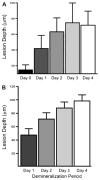Automated analysis of lesion depth and integrated reflectivity in PS-OCT scans of tooth demineralization
- PMID: 20077486
- PMCID: PMC3192502
- DOI: 10.1002/lsm.20862
Automated analysis of lesion depth and integrated reflectivity in PS-OCT scans of tooth demineralization
Abstract
Background and objectives: Several studies have demonstrated that polarization sensitive optical coherence tomography (PS-OCT) can be used to nondestructively measure the severity of subsurface demineralization in enamel and dentin, track lesion progression over time and measure remineralization. The purpose of this study was to develop methods for the automated assessment of the depth and severity of demineralization in PS-OCT scans.
Materials and methods: Subsurface caries-like lesions of increasing depth and severity were produced in adjoining windows on 10 bovine enamel samples via exposure to demineralization for periods of 1-4 days. PS-OCT scans were acquired for each sample and analyzed using various methods to calculate the lesion depth and severity. Edge detection algorithms were most successful for measurement of the lesion depth for improved assessment of lesion severity.
Results: Edge-finding algorithms were able to detect significant differences (P<0.05) in the lesion depth and severity between each of the periods of demineralization and sound enamel. The lesion depth and mineral loss were also measured with polarized light microscopy and transverse microradiography after sectioning the teeth for comparison.
Conclusions: This study demonstrates that the depth and severity of early lesions can be calculated automatically for rapid analysis of PS-OCT images.
Figures







Similar articles
-
Methods for calculating the severity of demineralization on tooth surfaces from PS-OCT scans.Proc SPIE Int Soc Opt Eng. 2009 Feb 18;7162(1):71620U. doi: 10.1117/12.816867. Proc SPIE Int Soc Opt Eng. 2009. PMID: 21935290 Free PMC article.
-
Polarization-sensitive optical coherence tomographic imaging of artificial demineralization on exposed surfaces of tooth roots.Dent Mater. 2009 Jun;25(6):721-8. doi: 10.1016/j.dental.2008.11.014. Epub 2009 Jan 23. Dent Mater. 2009. PMID: 19167052 Free PMC article.
-
Non-destructive assessment of inhibition of demineralization in dental enamel irradiated by a lambda=9.3-microm CO2 laser at ablative irradiation intensities with PS-OCT.Lasers Surg Med. 2008 Jul;40(5):342-9. doi: 10.1002/lsm.20633. Lasers Surg Med. 2008. PMID: 18563781
-
Nondestructive assessment of dentin demineralization using polarization-sensitive optical coherence tomography after exposure to fluoride and laser irradiation.J Biomed Mater Res B Appl Biomater. 2009 Aug;90(2):802-12. doi: 10.1002/jbm.b.31349. J Biomed Mater Res B Appl Biomater. 2009. PMID: 19283826 Free PMC article.
-
Assessment of demineralized tooth lesions using optical coherence tomography and other state-of-the-art technologies: a review.Biomed Eng Online. 2022 Dec 3;21(1):83. doi: 10.1186/s12938-022-01055-x. Biomed Eng Online. 2022. PMID: 36463182 Free PMC article. Review.
Cited by
-
High contrast reflectance imaging of simulated lesions on tooth occlusal surfaces at near-IR wavelengths.Lasers Surg Med. 2013 Oct;45(8):533-41. doi: 10.1002/lsm.22159. Epub 2013 Jul 16. Lasers Surg Med. 2013. PMID: 23857066 Free PMC article.
-
Auto-Segmentation and Quantification of Non-Cavitated Enamel Caries Imaged with Swept-Source Optical Coherence Tomography.Diagnostics (Basel). 2023 Dec 3;13(23):3586. doi: 10.3390/diagnostics13233586. Diagnostics (Basel). 2023. PMID: 38066827 Free PMC article.
-
Methods for Monitoring Erosion Using Optical Coherence Tomography.Proc SPIE Int Soc Opt Eng. 2013 Mar 25;8566:856606. doi: 10.1117/12.2011013. Proc SPIE Int Soc Opt Eng. 2013. PMID: 24465117 Free PMC article.
-
Evaluation methods of artificial demineralization protocols for coronal dentin: a systematic review of laboratory studies.BMC Oral Health. 2025 Apr 24;25(1):621. doi: 10.1186/s12903-025-05885-8. BMC Oral Health. 2025. PMID: 40275252 Free PMC article.
-
Non-Invasive Optical Coherence Tomography Data-Based Quantitative Algorithm for the Assessment of Residual Adhesive on Bracket-Removed Dental Surface.Sensors (Basel). 2021 Jul 7;21(14):4670. doi: 10.3390/s21144670. Sensors (Basel). 2021. PMID: 34300410 Free PMC article.
References
-
- NIH. Diagnosis and Management of Dental Caries throughout Life: NIH Consensus Statement; 2001 March 26–28, 2001. Report #18. :1–24. - PubMed
-
- Amaechi BT, Higham SM, Podoleanu AG, Rodgers JA, Jackson DA. Use of optical coherence tomography for assessment of dental caries. J Oral Rehabil. 2001;28(12):1092–1093. - PubMed
-
- Amaechi BT, Podoleanu AG, Komarov G, Higham SM, Jackson DA. Quantification of root caries using optical coherence tomography and microradiography: A correlational study. Oral Health Prev Dent. 2004;2(4):377–382. - PubMed
-
- Amaechi BT, Podoleanu A, Higham SM, Jackson DA. Correlation of quantitative light-induced fluorescence and optical coherence tomography applied for detection and quantification of early dental caries. J Biomed Opt. 2003;8(4):642–647. - PubMed
-
- Fried D, Xie J, Shafi S, Featherstone JDB, Breunig T, Lee CQ. Early detection of dental caries and lesion progression with polarization sensitive optical coherence tomography. J Biomed Opt. 2002;7(4):618–627. - PubMed
Publication types
MeSH terms
Grants and funding
LinkOut - more resources
Full Text Sources

